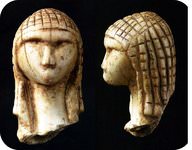19.7: Human Evolution
- Page ID
- 6052
\( \newcommand{\vecs}[1]{\overset { \scriptstyle \rightharpoonup} {\mathbf{#1}} } \)
\( \newcommand{\vecd}[1]{\overset{-\!-\!\rightharpoonup}{\vphantom{a}\smash {#1}}} \)
\( \newcommand{\id}{\mathrm{id}}\) \( \newcommand{\Span}{\mathrm{span}}\)
( \newcommand{\kernel}{\mathrm{null}\,}\) \( \newcommand{\range}{\mathrm{range}\,}\)
\( \newcommand{\RealPart}{\mathrm{Re}}\) \( \newcommand{\ImaginaryPart}{\mathrm{Im}}\)
\( \newcommand{\Argument}{\mathrm{Arg}}\) \( \newcommand{\norm}[1]{\| #1 \|}\)
\( \newcommand{\inner}[2]{\langle #1, #2 \rangle}\)
\( \newcommand{\Span}{\mathrm{span}}\)
\( \newcommand{\id}{\mathrm{id}}\)
\( \newcommand{\Span}{\mathrm{span}}\)
\( \newcommand{\kernel}{\mathrm{null}\,}\)
\( \newcommand{\range}{\mathrm{range}\,}\)
\( \newcommand{\RealPart}{\mathrm{Re}}\)
\( \newcommand{\ImaginaryPart}{\mathrm{Im}}\)
\( \newcommand{\Argument}{\mathrm{Arg}}\)
\( \newcommand{\norm}[1]{\| #1 \|}\)
\( \newcommand{\inner}[2]{\langle #1, #2 \rangle}\)
\( \newcommand{\Span}{\mathrm{span}}\) \( \newcommand{\AA}{\unicode[.8,0]{x212B}}\)
\( \newcommand{\vectorA}[1]{\vec{#1}} % arrow\)
\( \newcommand{\vectorAt}[1]{\vec{\text{#1}}} % arrow\)
\( \newcommand{\vectorB}[1]{\overset { \scriptstyle \rightharpoonup} {\mathbf{#1}} } \)
\( \newcommand{\vectorC}[1]{\textbf{#1}} \)
\( \newcommand{\vectorD}[1]{\overrightarrow{#1}} \)
\( \newcommand{\vectorDt}[1]{\overrightarrow{\text{#1}}} \)
\( \newcommand{\vectE}[1]{\overset{-\!-\!\rightharpoonup}{\vphantom{a}\smash{\mathbf {#1}}}} \)
\( \newcommand{\vecs}[1]{\overset { \scriptstyle \rightharpoonup} {\mathbf{#1}} } \)
\( \newcommand{\vecd}[1]{\overset{-\!-\!\rightharpoonup}{\vphantom{a}\smash {#1}}} \)
\(\newcommand{\avec}{\mathbf a}\) \(\newcommand{\bvec}{\mathbf b}\) \(\newcommand{\cvec}{\mathbf c}\) \(\newcommand{\dvec}{\mathbf d}\) \(\newcommand{\dtil}{\widetilde{\mathbf d}}\) \(\newcommand{\evec}{\mathbf e}\) \(\newcommand{\fvec}{\mathbf f}\) \(\newcommand{\nvec}{\mathbf n}\) \(\newcommand{\pvec}{\mathbf p}\) \(\newcommand{\qvec}{\mathbf q}\) \(\newcommand{\svec}{\mathbf s}\) \(\newcommand{\tvec}{\mathbf t}\) \(\newcommand{\uvec}{\mathbf u}\) \(\newcommand{\vvec}{\mathbf v}\) \(\newcommand{\wvec}{\mathbf w}\) \(\newcommand{\xvec}{\mathbf x}\) \(\newcommand{\yvec}{\mathbf y}\) \(\newcommand{\zvec}{\mathbf z}\) \(\newcommand{\rvec}{\mathbf r}\) \(\newcommand{\mvec}{\mathbf m}\) \(\newcommand{\zerovec}{\mathbf 0}\) \(\newcommand{\onevec}{\mathbf 1}\) \(\newcommand{\real}{\mathbb R}\) \(\newcommand{\twovec}[2]{\left[\begin{array}{r}#1 \\ #2 \end{array}\right]}\) \(\newcommand{\ctwovec}[2]{\left[\begin{array}{c}#1 \\ #2 \end{array}\right]}\) \(\newcommand{\threevec}[3]{\left[\begin{array}{r}#1 \\ #2 \\ #3 \end{array}\right]}\) \(\newcommand{\cthreevec}[3]{\left[\begin{array}{c}#1 \\ #2 \\ #3 \end{array}\right]}\) \(\newcommand{\fourvec}[4]{\left[\begin{array}{r}#1 \\ #2 \\ #3 \\ #4 \end{array}\right]}\) \(\newcommand{\cfourvec}[4]{\left[\begin{array}{c}#1 \\ #2 \\ #3 \\ #4 \end{array}\right]}\) \(\newcommand{\fivevec}[5]{\left[\begin{array}{r}#1 \\ #2 \\ #3 \\ #4 \\ #5 \\ \end{array}\right]}\) \(\newcommand{\cfivevec}[5]{\left[\begin{array}{c}#1 \\ #2 \\ #3 \\ #4 \\ #5 \\ \end{array}\right]}\) \(\newcommand{\mattwo}[4]{\left[\begin{array}{rr}#1 \amp #2 \\ #3 \amp #4 \\ \end{array}\right]}\) \(\newcommand{\laspan}[1]{\text{Span}\{#1\}}\) \(\newcommand{\bcal}{\cal B}\) \(\newcommand{\ccal}{\cal C}\) \(\newcommand{\scal}{\cal S}\) \(\newcommand{\wcal}{\cal W}\) \(\newcommand{\ecal}{\cal E}\) \(\newcommand{\coords}[2]{\left\{#1\right\}_{#2}}\) \(\newcommand{\gray}[1]{\color{gray}{#1}}\) \(\newcommand{\lgray}[1]{\color{lightgray}{#1}}\) \(\newcommand{\rank}{\operatorname{rank}}\) \(\newcommand{\row}{\text{Row}}\) \(\newcommand{\col}{\text{Col}}\) \(\renewcommand{\row}{\text{Row}}\) \(\newcommand{\nul}{\text{Nul}}\) \(\newcommand{\var}{\text{Var}}\) \(\newcommand{\corr}{\text{corr}}\) \(\newcommand{\len}[1]{\left|#1\right|}\) \(\newcommand{\bbar}{\overline{\bvec}}\) \(\newcommand{\bhat}{\widehat{\bvec}}\) \(\newcommand{\bperp}{\bvec^\perp}\) \(\newcommand{\xhat}{\widehat{\xvec}}\) \(\newcommand{\vhat}{\widehat{\vvec}}\) \(\newcommand{\uhat}{\widehat{\uvec}}\) \(\newcommand{\what}{\widehat{\wvec}}\) \(\newcommand{\Sighat}{\widehat{\Sigma}}\) \(\newcommand{\lt}{<}\) \(\newcommand{\gt}{>}\) \(\newcommand{\amp}{&}\) \(\definecolor{fillinmathshade}{gray}{0.9}\)What is a "cave man"?
What if you were to wake up with a group of Neanderthals? They were close relatives to modern humans. Still, you might find them to be a bit different from your usual friends.
Human Evolution
Humans evolved during the later Cenozoic. New fossil discoveries continue to alter the details of what we know about human evolution. The major evolutionary events are well understood though.
Primate Ancestors
Humans evolved from primates, a group of mammals that includes lemurs, monkeys and apes. Humans are part of the apes, but we did not evolve from apes, which also include chimpanzees and gorillas. Apes and humans have a primate common ancestor. About 5 to 7 million years ago, chimpanzees (our closest living relatives) and humans shared their last common ancestor.
Hominids
Animals of the genus, Ardipithecus lived roughly 4 to 6 million years ago. These animals had brains roughly the size of a female chimp. Although they lived in trees, they were bipedal. That is, they could stand on two feet. What are the advantages to being bipedal? An organism that can stand up can see farther. This is important if you live in a grassland. A bipedal organism uses its hands and arms for hunting.
Another human ancestor, Australopithecus afarensis lived between 3.9 and 2.9 million years ago (Figure below). These animals were completely bipedal. Their brains grew rapidly across the generations.
Australopithecus afarensis is a human ancestor that lived about 3 million years ago.
Homo
The genus Homo, in which modern humans are the only living species, appeared about 2.5 million years ago. These human-like primates developed the first stone tools. Homo erectus evolved in Africa about 1.8 million years ago. Fossils of these animals show a much more human-like body structure. This allowed them to travel long distances to hunt. Cultures began and evolved.
Homo sapiens
Homo sapiens is our species. We originated about 200,000 years ago in Africa. Evidence of a spiritual life appears about 32,000 years ago. The evidence includes stone figurines that probably have religious significance (Figure below).
Stone figurines likely indicate a spiritual life.
The ice ages allowed humans to migrate. During the ice ages, water was frozen in glaciers. Land bridges such as the Bering Strait allowed humans to walk from Asia to North America.
Summary
- Australopithecus afarensis was completely bipedal and had a growing brain.
- Homo erectus evolved 1.8 million years ago. These organisms left behind signs of an early culture.
- Our species is Homo sapiens. We evolved 200,000 years ago in Africa, and spread.
Review
- Why is being bipedal a good thing?
- What is the evidence that humans evolved from apes?
- Why are the ice ages important for the spread of modern humans?
Explore More
Use the resource below to answer the questions that follow.
- What was Darwin's little heresy?
- What was "the missing link" thought to be?
- Why weren't the Neanderthal and Homo erectus fossils that were found thought to be the missing link?
- What was the problem with the fossil evidence from Africa? What was found to be incorrect and why?
- Why is it difficult to identify whether an apelike fossil is a direct human ancestor or not?
- List the traits that separate humans from apes.
- Why did the DNA of humans and apes seem as if they did not share a common evolutionary ancestor? How was that resolved?
- When was the last common ancestor between chimps and humans? When was the last between Neanderthal and humans?
- What is the scientific evidence for the creation of humans by a deity?




